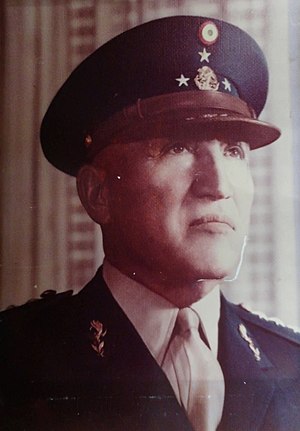Nochehuatl Rodriguez: Difference between revisions
No edit summary |
|||
| Line 51: | Line 51: | ||
| rank = Lieutenant General | | rank = Lieutenant General | ||
| education = [[Cendejas Imperial Military School]] | | education = [[Cendejas Imperial Military School]] | ||
| party = [[Party for the Cárinansian Revolution]] | |||
}} | }} | ||
Revision as of 04:40, 5 May 2024
Nōchēhuatl Rodríguez | |
|---|---|
 Military portrait in 1978 | |
| National Senator of Ipudorm for Gran Salvador | |
| In office 29 July 2004 – 1 March 2019 | |
| Preceded by | Mateo Espina |
| Succeeded by | Cuetlāchtli Ixtanyatl |
| National Senator of San Luis for Chihuatanec | |
| In office 25 June 1989 – 24 June 2001 | |
| Preceded by | Gustavo Zoido |
| Succeeded by | Juan Carlos Sanchez |
| Governor of Tohuecotl | |
| In office 14 August 1980 – 14 August 1988 | |
| Preceded by | Rebeca Villa |
| Succeeded by | Centehua Martinéz |
| Duke of Solicalco | |
| In office 4 January 1940 – 23 October 1959 | |
| Preceded by | Roberto Cortés, 5th Duke of Solicalco |
| Succeeded by | Title dissolved |
| Personal details | |
| Born | Oscar Cortés January 2, 1932 São Alberto, Imperial State of Carinansia |
| Died | August 17, 2036 (aged 104) Puerto Encantado, Ipudorm, Carinansia |
| Political party | Party for the Cárinansian Revolution |
| Children |
|
| Parent(s) | Roberto Cortés, 5th Duke of Solicalco (father) Lady Diana of Flores (mother) |
| Education | Cendejas Imperial Military School |
| Military service | |
| Allegiance |
|
| Branch/service | Serene Army |
| Rank | Lieutenant General |
| Commands |
|
| Battles/wars | |
| Military awards |
|
Nōchēhuatl Rodríguez, born Oscar Cortés (January 2, 1932 - August 17, 2036) to aristocracy living in São Alberto, he received a privileged and educated upbringing in the capital. He enlisted in the Imperial Army in 1950 as an officer cadet, rising quickly through the ranks due to his peerage to become a Brigadier General by 1958, in command of the Army of Southern Ipudorm. Consdering himself a Serenist sympathiser, he quickly pledged allegiance to the National Liberation Front later that year, ultimately becoming a prominent revolutionary General. In the later years of the Serenacy, he became one of the country’s most prominent politicians, serving as governor and senator several times.
Family background
House Cortés was one of the Imperial State's most prominent aristocratic families, descending from Beltrán Cortés, an early leader for independence who fought alongside Alberto I, and was one of the signatories to the Treaty of Seoyang in 1835. In gratitude for his service, Beltrán was made the first Duke of Solicalco, and though he died only eight years later, he had already initiated the family's history of noble intermarriage, bearing children with Caterina, Countess of Galiano. By the birth of Rodríguez, the family had a strong history of military service to the state, seeing their members die young during battle, but also accumulating several titles by marrying into various noble houses, making them among the wealthiest families in the country.
Early life and education
Early life
He was born in São Alberto as the eldest child of Roberto Cortés (1908-1940), who was the eldest son of Alejandro Cortés Dominguez, 4th Duke of Solicalco, and Daniela Cortés Marchena, Marquise of Hivia. His mother was Diana Cortés, Lady of Flores (1905–1962), daughter of Ignacio Balboa Pallares, Lord of Flores, and Diana Balboa de Anchieta, Countess of Alzado.
Imperial education
Military career
Imperial State (1950-1959)
Defense of Plaimo
Battle of Puerto Real
Revolutionary Period (1959-1965)
Allegiance to the National Liberation Front
Battle of Matagoza
Battle of Cidade do Ouro
Battle of Anáheiro
Battle of São Alberto
Serenacy (1965-1977)
Battle of La Junvier
Discharged period
Shortly after receiving an honourable discharge in 1977, retiring from the Serene Army as one of the most senior and respected military officers in the country, he formally renounced all properties he inherited from his father. He donated the Cortés Hacienda in Cintero province, Tohuecotl, to the state government, to serve as a secondary residence for the governor. He sold all the properties he owned in the Albert neighbourhood of Voclaria City, donating all proceeds to charity, and sold the Solicalco palace to a private investor. The only properties he retained were Flores Manor in São Lenoas, and Sara House in Teecamatl, Tohuecotl, the former becoming his primary residence until moving to Tohuecotl, and the latter becoming his primary residence in the state, in place of the Governors' Mansion.